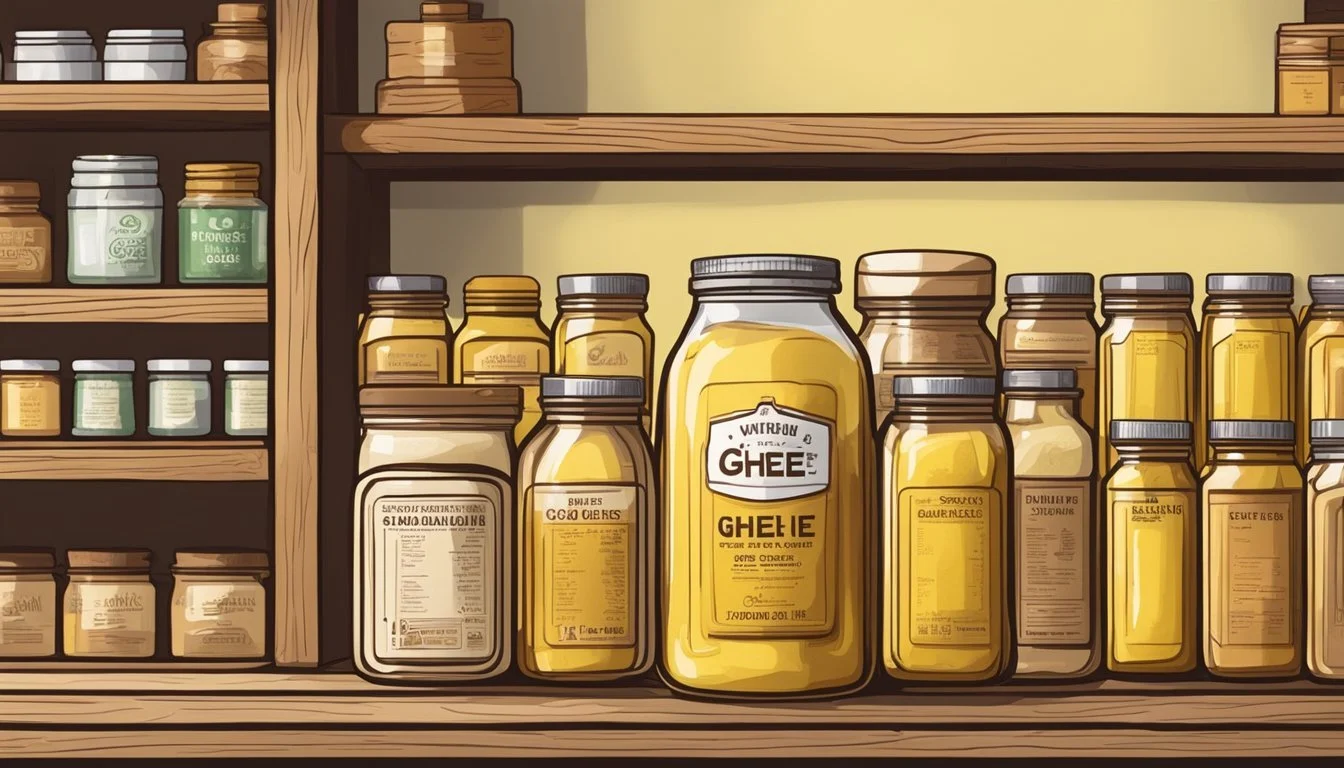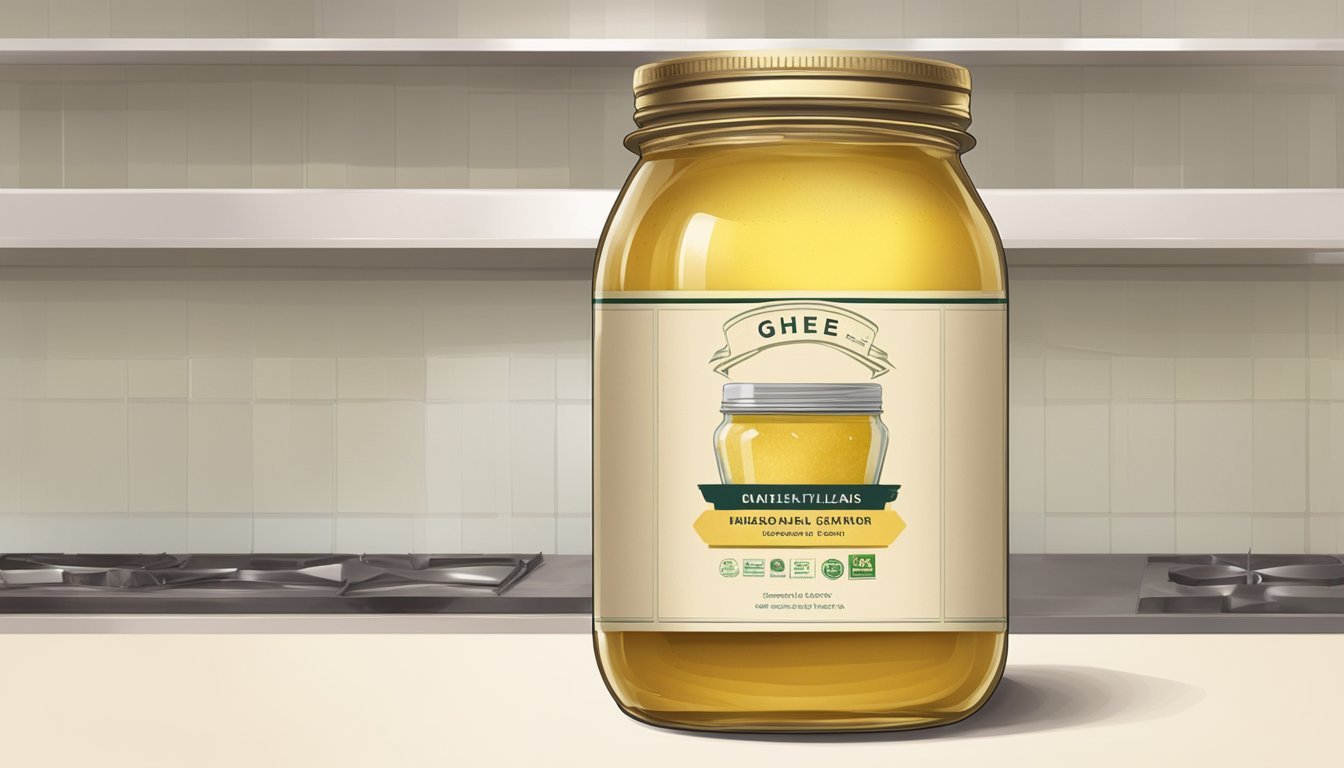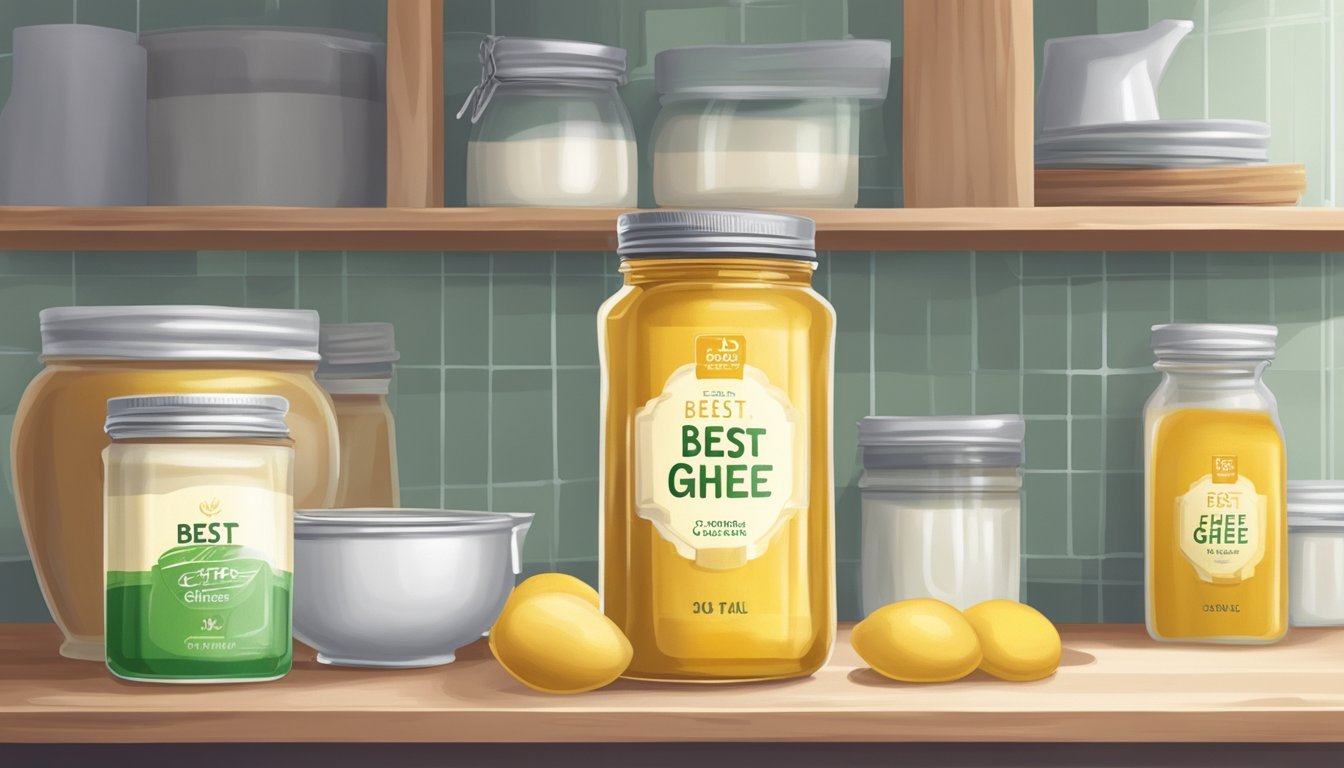How Long Does Ghee Last?
Understanding Its Shelf Life and Storage Tips
Ghee (how long does ghee last?), often referred to as clarified butter, is a staple in many cuisines and known for its rich, nutty flavor and high smoke point. It's made by simmering butter to separate milk solids from the liquid fat, resulting in a product that is more resistant to spoilage than regular butter. Because ghee is pure fat, free from water and milk solids, it boasts a longer shelf life which can be a deciding factor for consumers seeking a durable cooking oil.
The shelf life of ghee is impressive, as it typically lasts at least 1 to 2 years if stored properly, and can be extended further by refrigeration. Identifying spoiled ghee is relatively straightforward: it develops a sour taste and an off-odor that might resemble old paint or nail polish remover — clear signs that it has gone rancid. Efficient storage involves keeping ghee in an airtight container away from direct light and heat to maximize its freshness and ensure it remains a flavorful addition to meals.
Understanding Ghee
Ghee, a form of clarified butter, is prized for its rich flavor, high smoke point, and extended shelf life due to the removal of milk solids.
Composition and Characteristics
Ghee is essentially butterfat with milk solids and water removed through a simmering process. This leaves pure butterfat, which gives ghee its nutty taste and smooth texture. The absence of milk solids allows for a higher smoke point compared to regular butter, making it suitable for high-heat cooking. Moreover, ghee is resistant to spoilage because its purity makes it less hospitable to bacterial growth.
Main Components: Pure butterfat, minimal moisture.
Smoke Point: Higher than regular butter, around 482°F (250°C).
Texture and Taste: Smooth, nutty, and rich.
Comparison to Other Fats
Ghee is distinctive among cooking fats due to several attributes:
Smoke Point: With one of the highest smoke points, it surpasses common oils like olive oil, thus suitable for frying and sautéing.
Shelf Life: Ghee's longevity eclipses that of many other fats — it can last years, unlike conventional butter which may spoil within weeks without refrigeration.
Nutritional Profile: Lactose-free and casein-free, ghee can be a better alternative for those with dairy sensitivities.
Olive Oil: Lower smoke point and a different nutrient profile.
Regular Butter: Contains milk solids and moisture, lower smoke point, shorter shelf life.
Other Cooking Fats: Few have the combined attributes of flavor, stability, and heat tolerance like ghee.
Shelf Life Fundamentals
A thorough understanding of ghee's shelf life is essential for maximizing its usability and retaining its flavor and nutritional value. The section below details the fundamental aspects of determining ghee's shelf life and the factors that influence its longevity.
Determining Ghee's Shelf Life
Unopened Ghee: Typically, unopened ghee has a shelf life of 1 to 2 years when stored properly at room temperature, away from direct sunlight and heat sources. The best-before date or best-by date on the packaging can serve as a reliable indicator of its optimal quality period.
Opened Ghee: Once opened, the shelf life reduces. It can last for approximately six months in a cabinet at room temperature or up to one year if refrigerated. However, these time frames can vary based on the storage conditions and the quality of the ghee.
Factors Affecting Ghee's Longevity
Several factors can impact the shelf life of ghee:
Storage Temperature: A cool, dark place is ideal. Heat can cause ghee to spoil more quickly.
Humidity: Excess moisture can lead to spoilage; thus, storage in a dry area is preferable.
Container Seal: Proper sealing of the container after each use helps keep contaminants out, preserving the ghee for a longer duration.
Light Exposure: Prolonged exposure to light can degrade the quality of ghee; opaque containers help mitigate this risk.
Should ghee surpass its expiration date or exhibit a rancid smell, a bitter taste, or a change in texture, it should be considered expired and discarded to avoid consumption of spoiled food.
Storage Guidelines
Maintaining the quality and extending the shelf life of ghee depends on proper storage. The conditions under which ghee is kept play a critical role in its preservation.
Optimal Storage Conditions
Ghee should be stored in a cool and dry place such as a kitchen cabinet. Exposure to heat, light, and moisture can degrade its quality. Ideally, it should be kept in a tightly sealed container to prevent oxidation, which can cause rancidity. Storing ghee in a dark place, away from sunlight, is essential to preserve its integrity.
Refrigeration vs. Pantry
While ghee is shelf-stable, some prefer to store it in the refrigerator to prolong its freshness. Refrigeration is not necessary but can be beneficial if the ambient temperature is high or if the ghee will not be used quickly. If one opts for pantry storage, it is crucial to ensure the space is cool and not exposed to temperature fluctuations.
Freezing Ghee for Extension of Shelf Life
Ghee can be frozen to extend its shelf life even further. When freezing ghee, it is advisable to portion it into usable amounts, as it does not need to be thawed completely for use. Store the portions in freezer-safe containers or freezer bags to prevent freezer burn. Frozen ghee can be kept for an extended period without compromising its quality.
Indicators of Spoilage
When assessing ghee for spoilage, one should observe any sensory changes that indicate a decline in quality. Physical and chemical changes are also key in determining if the ghee has gone rancid.
Sensory Changes
Smell: Fresh ghee has a rich, nutty aroma. The presence of an off smell, similar to old paint or nail polish remover, suggests that the ghee may have turned rancid. If the ghee emits a sour or otherwise unpleasant odor, it is no longer suitable for consumption.
Taste: Ghee should taste slightly sweet with a full, creamy texture. A harsh, bitter, or sour flavor is a clear sign of spoilage. Consumption of rancid ghee is not recommended due to potential health risks.
Physical and Chemical Changes
Discoloration: Good quality ghee has a uniform golden-yellow color. Any signs of discoloration, such as darkening or lighter patches, may indicate spoilage.
Mold: While rare, the presence of mold on ghee signifies that moisture has entered the container, and the product should be discarded. Ghee should be smooth and free of any growths or foreign particles.
Usage and Application
Ghee is a versatile ingredient in both kitchen settings and various non-culinary applications due to its high smoke point and moisturizing properties.
Culinary Uses
Ghee holds a prestigious place in Indian cuisine, where it's frequently applied for its aromatic richness and the depth of flavor it imparts to dishes. Its high smoke point—around 482 degrees Fahrenheit (250 degrees Celsius)—makes it extremely suitable for sautéing and frying. Unlike butter, ghee withstands high temperatures without burning, thus it's ideal for cooking methods that require sustained heat.
Cooking: Ghee serves as a medium for conveying and enhancing flavors, whether for simmering spices for a curry or caramelizing onions.
Saute: It provides an excellent fat for sauteing vegetables, meats, and other diet mainstays, adding a subtle nutty essence without overpowering natural tastes.
Non-Culinary Uses
Beyond the kitchen, ghee finds usefulness due to its nourishing and hydrating qualities.
Skin Moisturizer: The rich consistency of ghee makes it an effective skin moisturizer, particularly in dry climates.
Hair Oil: For hair care, ghee is used as a conditioning treatment, offering a natural alternative to commercial hair oils.
Makeup Remover: Its oily texture allows ghee to function as a gentle and effective makeup remover.
Ghee's versatility extends from sautéing ingredients at high temperatures in culinary tradition to nourishing the body outside the realm of cooking.
Health and Safety Considerations
Ghee is a dairy product that is generally valued for its long shelf life and rich flavor. However, proper storage and handling are crucial to ensure that it remains safe for consumption and free of spoilage and mold.
Safe Consumption
It is essential to understand that ghee, while having a longer shelf life compared to regular butter, can still go bad. Spoilage is typically noticeable through changes in taste, color, and aroma. Ghee that has gone rancid will have a sour taste and possibly a discoloration. The presence of mold, which appears as fuzzy spots of various colors, indicates that ghee is no longer safe for consumption. Users should discard any ghee that shows signs of spoilage or mold to avoid health risks.
Avoiding Contamination
To ensure ghee remains free from contaminants that can hasten spoilage, these measures should be followed:
Always use clean utensils to scoop ghee to prevent the introduction of bacteria.
Keep the container sealed when not in use to limit exposure to air and moisture.
Store ghee in a cool, dry place, away from direct sunlight. If these conditions are met, ghee can last for an extended period, typically 1 to 2 years unopened and up to a year after opening.
Refrigeration after opening is recommended, especially in warmer climates, to further extend its shelf life.
Ghee's Varieties and Labels
When shopping for ghee, consumers will encounter an array of options, from various commercial brands to the choice of homemade ghee. Labeling, such as "organic" or "grass-fed," gives insight into the quality and origin of the ingredients.
Commercial Brands
Commercially available ghee typically comes from dairy collected from cows that may or may not be grass-fed. Brands often distinguish their ghee with labels such as organic or grass-fed, indicating that the cows were given organic feed or grazed on grass, respectively. Consumers can find a best before date on the label, which can be useful in gauging the shelf life. An interesting variety to note is full moon ghee, said to be made during the full moon to enhance its vibrational qualities.
Organic Ghee: Certified to have been made from the milk of cows fed with organic feed.
Grass-fed Ghee: The cows are fed a diet consisting mainly of grass, which can influence the ghee's taste and nutrition profile.
Labels are not just marketing; they can reflect the type of care the cows received and the practices involved in the ghee-making process.
Homemade Ghee
Homemade ghee, tailored by individuals at home, lacks commercial labels but offers a unique experience. The maker has control over the source of the butter, often choosing organic or milk from grass-fed cows based on personal preference. Homemade ghee may vary in flavor and color due to the differences in milk sources and preparation methods. While there is no official shelf-life label, homemade ghee stored properly can last a significant amount of time, similar to store-bought varieties.
Homemade Ghee Variables:
Source of butter (organic, grass-fed)
Preparation method
Storage conditions
What distinguishes homemade ghee is its customizable nature, where individuals can apply their own standards similar to what they might seek in store-bought labels.
Practical Tips and Tricks
Preserving the quality of ghee for as long as possible involves proper storage and handling techniques. This section provides targeted strategies to achieve just that, as well as insights into alternative fats that can be used if ghee is no longer viable.
Extending Ghee's Usability
To extend the shelf life of ghee, one must consider the storage environment and container choice. Keeping ghee in an airtight container is imperative to prevent oxidation, which can lead to rancidity. Below are detailed measures one can take:
Temperature: Store in a cool, dark place to maintain quality.
Sealing: Always seal the container tightly after use.
Quantity: Consider dividing ghee into smaller portions to avoid frequent exposure to air.
Freezing Ghee: While it is not usually necessary due to ghee's long shelf life, it can be frozen to extend usability even further. Ensure it's in an airtight container or double-wrapped to prevent freezer burn.
Do Don't Use clear jars to monitor for changes in clarity. Leave the lid ajar or the container unsealed. Label with date to track shelf life. Expose to fluctuating temperatures and moisture. Defrost frozen ghee slowly in the refrigerator. Refreeze after thawing to prevent quality loss.
Alternative Fats and Substitutes
When ghee is not an option, either due to expiration or preference, there are several alternatives that can be used in cooking. Each has its own properties and benefits:
Bacon Grease: Imparts a rich, smoky flavor suitable for frying or sautéing. Should be used quickly or stored in the refrigerator.
Lard: Another animal fat with a high smoke point, perfect for high-heat cooking.
Coconut Oil: A plant-based substitute that offers a sweet, light taste and is solid at room temperature.
To choose the appropriate alternative, one must consider the smoke point and flavor profile of the fat in relation to the dish being prepared. As with ghee, these substitutes should also be stored correctly—typically in a cool, dark place or refrigerated if the product is prone to rancidity.
Advanced Knowledge
In the realm of ghee storage and longevity, environmental conditions and the onset of rancidity are critical factors. Understanding these elements ensures optimal preservation and usage.
Ghee in Different Environments
Ghee’s shelf life varies widely based on its storage environment. Key considerations include temperature, light exposure, and sealing:
Temperature: Ghee is best kept in a cool, stable environment. Fluctuating or high temperatures can accelerate spoilage.
Light Exposure: Direct sunlight has a deleterious effect on ghee, hastening rancidity. It's prudent to store ghee in a dark place or opaque container.
Sealing: Properly sealed containers are paramount in safeguarding against moisture and maintaining consistency.
A table summarizing ideal storage environments for ghee:
Condition Effect on Ghee Shelf Life Cool Temperature Extends shelf life Dark Environment Prevents oxidative damage Airtight Sealing Preserves freshness
Understanding Rancidity in Ghee
Rancidity is a destructive process affecting the quality of ghee. Here’s what one needs to know:
Cause: Rancidity in ghee arises from oxidation, a chemical reaction that occurs when ghee is exposed to oxygen, light, or heat.
Identification: The indicators of rancidity include a sour or off smell, discoloration to a stark white, and a sharp, unpleasant taste.
Expired Ghee: The use-by date on ghee is a good indicator of when it might begin losing its quality, but smell and taste are definitive tests.
Rancidity does not occur suddenly but gradually, meaning one can sometimes extend the life of their ghee with proper storage, even beyond the best-by date.
FAQs and Common Concerns
When discussing ghee longevity, two critical considerations are how to handle expired ghee and the best container types for maximising its shelf-life.
Handling Expired Ghee
Expired ghee can exhibit signs of spoilage such as a sour aroma or a strange taste. If these signs are present, it should not be consumed. Container type and storage conditions play significant roles in how far beyond the expiration date ghee can potentially last. They are typically shelf-stable for 1 to 2 years if unopened and stored properly. Once opened, ghee is best used within 3 to 6 months, although it may last up to a year when refrigerated.
Choosing the Right Container
Glass jars are often recommended for storing ghee because they provide a better barrier against oxygen and light, which can accelerate spoilage. Plastic containers may also be used but may not offer the same level of protection over time, especially if the plastic is not food-grade or is subject to direct sunlight. Regardless of material, the container should be airtight to preserve ghee’s quality. Refrigerated ghee remains safe and high-quality for longer periods but should always be stored in a well-sealed container to protect it from absorbing other refrigerator odors.
Optimal Containers for Ghee Storage:
Airtight seal
Light-blocking properties (if not stored in a dark place)
Glass over plastic for extended shelf-life










